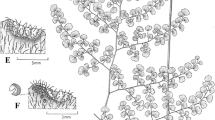Abstract
The plantLavandula gibsonii (fam. Lamiaceae) has been found to possess various insectistatic activities against several insect pests. Acetone extracts of the whole plant exhibit ovicidal, antifeedant, antigonadal, oviposition-deterrent and repellent properties against different insect species. The insectistatic potential ofL. gibsonii is compared with that of neem and possibilities of exploitation are discussed.
Similar content being viewed by others
References
Beck, S.D. (1965) Resistance of plants to insects.A. Rev. Ent. 10: 207–232.
Beye, F. (1978) Insecticides from the vegetable kingdom.Pl. Res. Devel. 7: 15–32.
Bowers, W.S., Ohta, T., Cleere, J.S. and Marsella, P.A. (1976) Discovery of insect antijuvenile hormones in plants.Science, N.Y. 193: 542–546.
Fraenkel, G. (1969) Evaluation of our thoughts on secondary plant substances.Entomologia exp. appl. 12: 473–486.
Hedin, P.A., Maxwell, F.G. and Jenkins, J.N. (1974) Insect plant attractants, feeding stimulants, repellents, deterrents, and other related factors affecting insect behavior.Proc. of the Summer Institute on Biological Control of Plant Insects and Diseases. Maxwell, F.G. and Harris, F.A. [Eds.] University Press of Mississippi, Jackson, MS.
Jacobson, M., Reed, D.K., Crystal, M.M., Moreno D.S. and Soderstrom, E.L. (1978) Chemistry and biological activity of insect feeding deterrents from certain weed and crop plants.Entomologia exp. appl. 24: 448–457.
Ladd, T.L., Jr., Jacobson, M. and Buritt, C.R. (1978) Japanese beetles: extracts from neem tree seeds as feeding deterrents.J. econ. Ent. 71: 810–813.
Levinson, H.Z. (1975) Possibilities of using insectistatics and pheromones in pest control.Naturwissenschaften 62: 272–282.
Pradhan, S. and Jotwani, M.G. (1971) Repeated confirmation of our discovery of antifeedant property of neem kernel.Ent. Newsl. 1: 75–77.
Sharma, R.N. (1979) Plant products in the development of new pest control strategies. Workshop on “Futurology on Use of Chemicals in Agriculture with Particular Reference to Future Trends in Pest Control.” Coimbatore, India. p. 17.
Slama, K. (1969) Plants as a source of materials with insect hormone activity.Entomologia exp. appl. 12: 721–728.
Sondheimer, E. and Simeone, J.B. [Eds.] (1970) Chemical Ecology. Academic Press, New York, NY.
Author information
Authors and Affiliations
Additional information
NCL Communication No. 2576.
Rights and permissions
About this article
Cite this article
Sharma, R.N., Bhosale, A.S., Joshi, V.N. et al. Lavandula gibsonii: A plant with insectistatic potential. Phytoparasitica 9, 101–109 (1981). https://doi.org/10.1007/BF03158452
Received:
Revised:
Issue Date:
DOI: https://doi.org/10.1007/BF03158452




